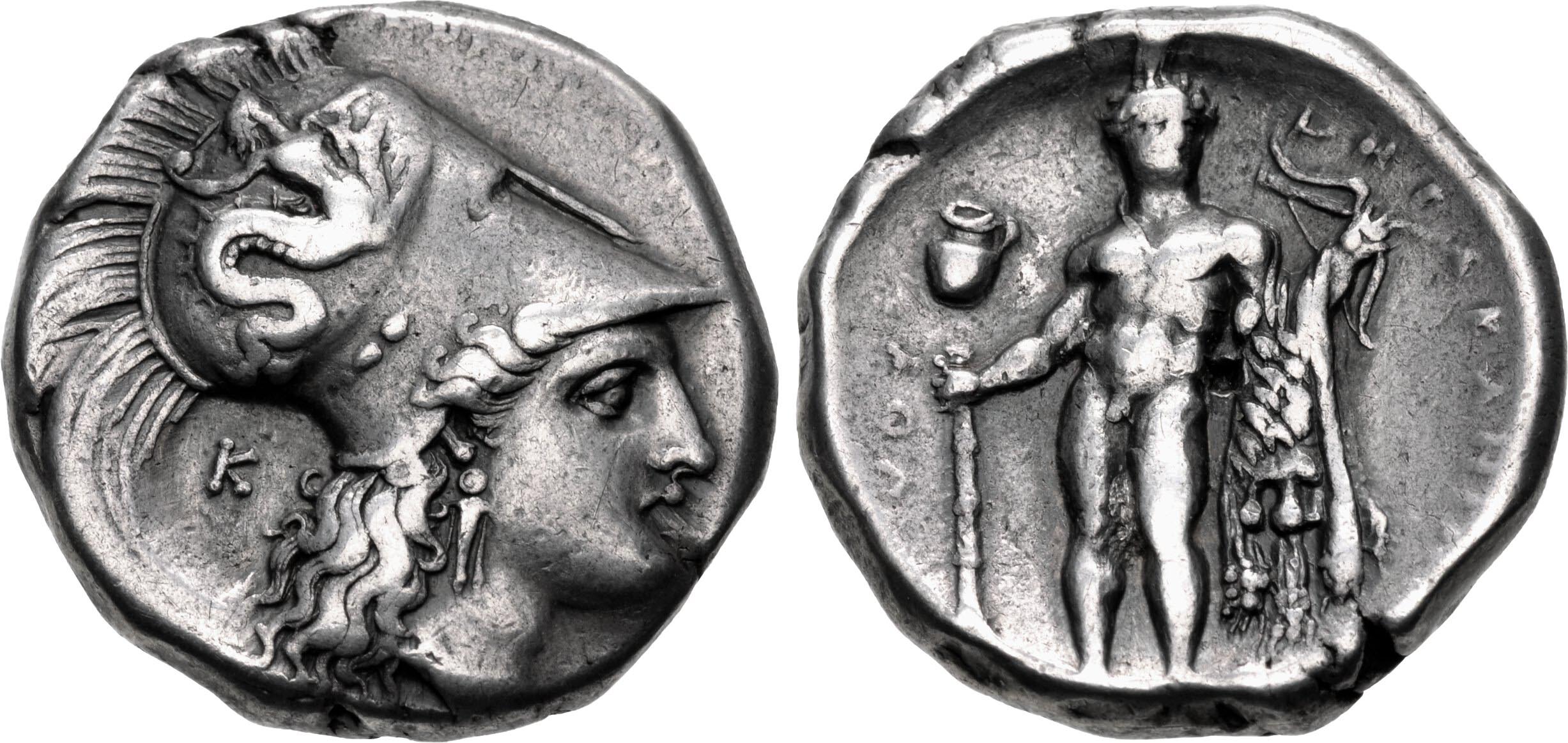Heraclea Lucaniae, silver, didrachms (Athena/Heracles) (370-281 BCE)
From SILVER
370 BCE - 281 BCE Silver 2,996 kg
Description
| ObverseInscription or printing placed on the obverse.: | (HPAKΛHIΩN) (Greek).Head of Athena right, wearing crested Attic helmet. Border of dots. |
| ReverseInscription or printing placed on the reverse.: | HPAKΛHIΩN (Greek).Heracles facing, holding lion's pelt over left arm, bow and club in hands. In field, symbol. |
Mint and issuing power
| MintIdentifies the place of manufacture or issue of a numismatic object.: | Heraclea Lucaniae | Ancient regionAncient region.: | Lucania | Modern countryModern country: Italy | AuthorityIdentifies the issuing power. The authority can be "pretended" when the name or the portrait of X is on the coin but he/she was not the issuing power. It can also be "uncertain" when there is no mention of X on the coin but he/she was the issuing power according to the historical sources: |
Chronology
| FromIdentifies the initial date in a range assigned in a numismatic context. | 370 BCE | toIdentifies the final date in a range assigned in a numismatic context.. | 281 BCE | PeriodTime period of the numismatic object.: Classical and Hellenistic |
Physical description
| MetalThe physical material (usually metal) from which an object is made.: | Silver |
Median weightMedian of the weights of numismatic objects (in grams). in grams | 7.85 | DenominationTerm indicating the value of a numismatic object. Examples: tetradrachm, chalkous, denarius.: | nomos | StandardStandard.: |
Image

RQEMH 2 - Heraclea Lucaniae, silver, stater, 370-281 BC.jpg [1]
References
| Die study referencePublication of the study: | Work 19401Work 1940, no. 49-92. | ||
| Coin series referenceReference to coin series study: | Sear I2Sear I, n° 391, RQEMH3RQEMH, n° 2, HN Italy4HN Italy, n° 1383-1387, HGC 15HGC 1, n° 981 | ||
| Coin series web referenceCoin series web references: | |||
Obverse dies distribution
| FrequencyFrequency of specimen in distribution. ᵖ | Number of obversesNumber of obverse dies. ᵖ (o) | % (o) | Number of coinsNumber of coins. (n) | % (n) | Die nameName(s) of the die(s). |
| 1 | 3 | 16.67 | 3 | 2.48 | 55, 56, 79 |
| 2 | 2 | 11.11 | 4 | 3.31 | 83, 84 |
| 3 | 1 | 5.56 | 3 | 2.48 | 88 |
| 4 | 1 | 5.56 | 4 | 3.31 | 90 |
| 5 | 4 | 22.22 | 20 | 16.53 | 52, 85, 91, 92 |
| 8 | 1 | 5.56 | 8 | 6.61 | 62 |
| 9 | 1 | 5.56 | 9 | 7.44 | 70 |
| 12 | 1 | 5.56 | 12 | 9.92 | 8 |
| 13 | 2 | 11.11 | 26 | 21.49 | 49, 64 |
| 15 | 1 | 5.56 | 15 | 12.4 | 74 |
| 17 | 1 | 5.56 | 17 | 14.05 | 57 |
| Total | 18 of 18 | 100.03 | 121 of 121 | 100.02 |
Reverse dies distribution
no distribution is available
Quantification
| Number of obversesNumber of obverse dies. ᵖ (o) | 18 | Number of singletons (o1)The number of singleton coins. ᵖ | 3 |
| Number of reverse diesNumber of reverse dies. (r) | 32 | Number of coinsNumber of coins. (n) | 121 |
| Coins per obverse dieNumber of coins per obverse die. (n/o) | 6.72 | Coins per reverse dieNumber of coins per reverse die. (n/r) | 3.78 |
| Reverse per obverse ratioRatio of obverse dies divided by reverse dies. (r/o) | 1.78 | Percentage of singletons (o1)number of coins (n) divided by the number of singletons (o1) ᵖ | 16.67 % |
| Original number of dies (O) (Carter 1983 formula)The estimation of the number of coins according to Carter 1983 ᵖ | 19.08 | Coins struck if 20,000 as average productivity per dieCoins made if the average productivity for obverses (according to Carter) is 20,000. ᵖ | 381,600 |
| Original number of dies (O) (Esty 2011 formula)The estimation of the number of coins according to the singleton formula in Esty 2011 ᵖ (O) | 21.15 | Survival rate if 20,000 as average productivity per dieSurvival rate if average productivity is 20,000. ᵖ | 0.00032 |
| Coverage (o = % of O) (Esty 1984 formula)Esty 1984 - coverage (% of O) ᵖ (o = % of O) | 97.52% | Die productivity if survival rate 1/2,000Average productivity if survival rate is 1/2,000. ᵖ | 12,683.44 |
| Weight of silver (in kg) if 20,000 coins per die (O = Carter formula)Carter 1983 * Median weight * 20000 (*10 if gold or electrum) ᵖ | 2,996 kg <br /> 2,996 kg | Die productivity if survival rate 1/5,000Average productivity if survival rate is 1/5,000. ᵖ | 31,708.6 |
Remarks